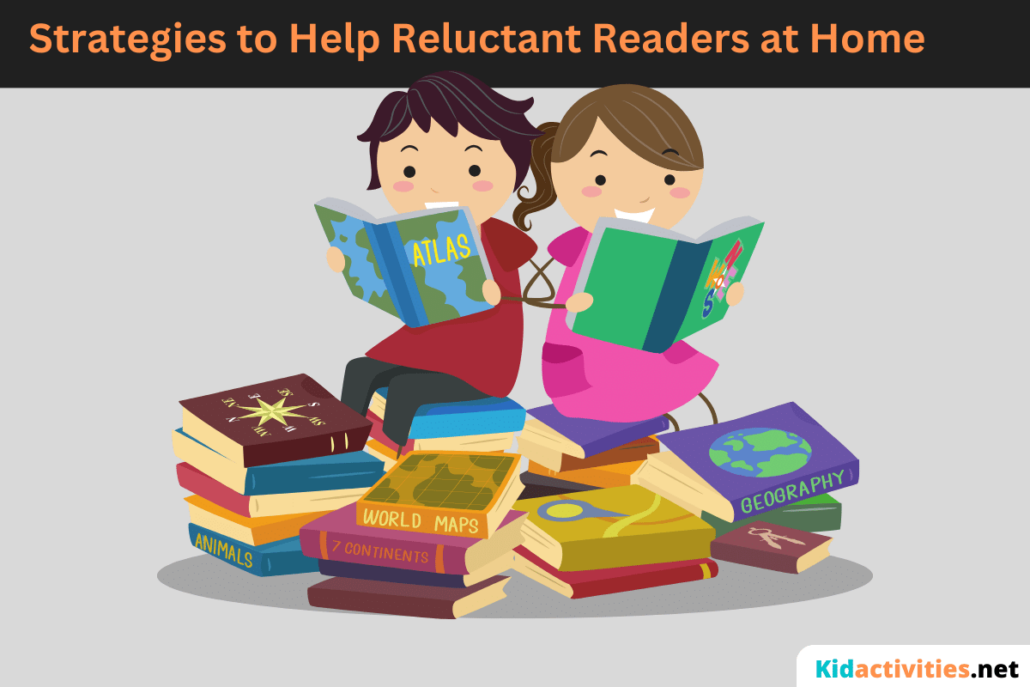Spanning the decades, schools have put a lot of incentives in place to encourage children to read. From D.E.A.R. (drop everything and read) to pizza coupons to school-wide reading competitions, schools have always encouraged children to enjoy good books and appreciate the adventure of reading.
According to my thoughts in this post, there is only one piece of homework I believe elementary students should have: reading with their families at home.
Even more than at school, it is so important for reading to be encouraged at home. Reading should be modeled for children by the parents and caregivers in the home to show the importance of books and reading.
Maybe you do all of these things, but your child still is not keen on reading. What happens if your child is a reluctant reader? I’ve got five tips to help you help your reader when you’re at home.
Tip #1 Choose a book at their level.
When you’re choosing a book to read as a family, think of goldilocks. As the story goes, she didn’t want the porridge that was too hot nor too cold. She wanted to eat the food that was just right for her.
It’s the same with reading levels. The book should not be too difficult so that children lose interest in the story, nor should the book be too easy so that there isn’t a challenge. The book that you read as a family should be just right.
How can you find the perfect book? A child’s independent reading level is usually lower than if they are reading with support. If you plan on reading the book out loud with your child, you can choose a book which is more challenging. This allows you to scaffold and support your child’s reading as you read together.
Tip #2 Don’t underestimate high-interest, low-level books.
High-interest, low-level books are books that are intentionally designed to create a lot of interest for readers but are not difficult in reading level. Graphic novels are a great example of high-interest, low-level books because they contain a lot of engaging cartoons and illustrations but may not contain challenging vocabulary words or content.
Contrary to the “stigma” of graphic novels not being true books, I think they are the perfect solution to keeping the interest of a child who doesn’t always enjoy reading. Graphic novels often help to fill the reading level gap between novels and beginning chapter books without making older children feel that the material is too young for them.
Some great high-interest, low-level, graphic-novel-type books are Fly Guy, Captain Underpants, Diary of a Wimpy Kid, Geronimo Stilton, Bad Kitty, and non-fiction books such as Magic Tree House fact trackers, the Who Would Win? series, and the Who Was….? series.
Tip #3 Create a Positive Reading Environment.
Reading together does not just mean that the children in the family have to read! You can take turns reading out loud and make it fun.
Just like in school during a class read aloud, you can try “popcorn” reading at home. One person starts reading, and they read as much as they want to. When they want to change readers, the person will say, “popcorn ______” with the next person’s name.
That person has to continue reading. It continues until you reach the place you want to stop. This method would work well if you have a larger family with many readers to choose from.
Another option to create a positive reading environment is to do a craft or activity while listening to the story. This could include doing handicrafts like knitting, crocheting, embroidering, etc. You could also work on a jigsaw puzzle while listening too.
Consistency is key! Do you have a time in your routine where reading out loud together as a family can easily fit in? My advice is to try to do it at the same time every day. Anything can become a habit if you do it long enough, including reading! Before too long, your kids will be reminding you about read aloud time because it’s part of their daily routine.
Have fun with it… do you have fun bean bags or cozy blankets you can bring out when you read? Make it special, memorable, and most of all, FUN!
Decide as a family what you will do if someone makes a mistake in reading. The common tendency is to correct the person who is reading. This can be helpful of course, but it can also cause the person reading to not want to read out loud for fear of making a mistake, especially if they are a reluctant reader. Instead, discuss it before you begin and offer reminders about the plan if needed.
Consider making one corner of your home or bedroom into a cozy reading space. Display some family favorite novels on a bookshelf with blankets, a diffuser, pillows, and anything else that will make it a fun place to read!
Tip #4 Offer choices.
Kids often like to feel like they are in control. Having them make a choice between two or three books to read is a great way to involve them in the reading process.
Take turns choosing which book to read together as a family. That way, everybody has a chance to share what they like with the rest of the family. You might even find a series that they whole family loves!
One thing to note is that some children may not be interested in reading or listening to fiction books. If this is the case, non-fiction, factual books may be just what they’re looking for. Try offering this option to your child if they are reluctant to read or listen to fiction novels.
Tip#5 Model reading when you can.
What children see adults doing, they will often replicate in their own lives. By modeling reading for your children, you are showing them where to invest their time.
By taking the time to read, you are not only taking time for yourself (win!), but you are also helping your child develop a love and appreciation for something that is so beneficial for them (win win!).
Above all, remember to ditch the parent guilt! Shame and guilt are not welcome in the journey of parenthood. You are doing a great job encouraging your child to fall in love with reading.
Even if you don’t see progress or fruit right away, keep the reading routines going. Consistency and time are the best ways to help reluctant readers.
There is no perfect formula for encouraging a reader. Each child is different and unique with their own ideas, likes, and dislikes, which means what works for one child may not work for another.
Ultimately, the best thing that you can give your child is love, support, and guidance. By keeping these five tips in mind, you can guide your children as they begin to navigate their journey of learning to love reading.

